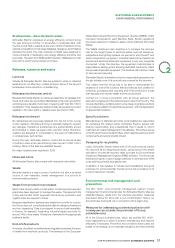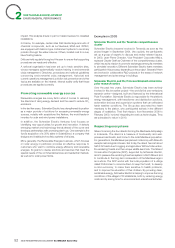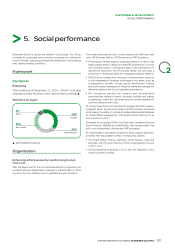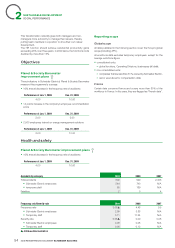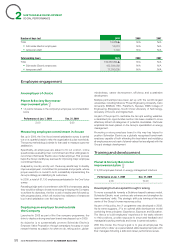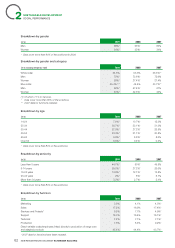APC 2009 Annual Report Download - page 54
Download and view the complete annual report
Please find page 54 of the 2009 APC annual report below. You can navigate through the pages in the report by either clicking on the pages listed below, or by using the keyword search tool below to find specific information within the annual report.
2009 REGISTRATION DOCUMENT SCHNEIDER ELECTRIC52
SUSTAINABLE DEVELOPMENT
2ENVIRONMENTAL PERFORMANCE
impact. This analysis draws in part on hazard reviews for classifi ed
installations.
In France, for example, certain sites that handle large amounts of
chemical compounds, such as Le Vaudreuil, MGA and 38TEC ,
are equipped with balloon-type containment systems to avoid any
pollution through the water network. Others, located next to a river,
have fl oating beams.
Drills are held regularly throughout the year to ensure that supporting
procedures are ready and effective.
A national organisation has been set up to track sensitive sites,
whose managers systematically receive training in environmental
crisis management. Directives, procedures and national guidelines
concerning environmental crisis management, historical and
current operations management, pollution risk prevention and other
topics are available on the intranet. Internal audits verify that these
procedures are applied correctly.
Promoting renewable energy sources
Renewable energies are a key factor when it comes to resolving
the dilemma of rising energy demand and the need to reduce CO2
emissions.
In the last few years, Schneider Electric has strengthened its position
as a major provider of solutions for accessing renewable energy
sources, notably with acquisitions like Xantrex, the world leader in
inverters for solar and wind power installations.
In addition, the Schneider Electric Ventures fund focuses on
identifying new opportunities for growth and innovation. It detects
emerging market and technology trends ahead of the curve and
develops partnerships with promising start-ups. One example is the
fund’s acquisition of a 20% stake in SolaireDirect, a company that
designs and installs photovoltaic systems of all sizes.
More generally, the Renewable Energies business, which focuses
on solar energy in particular, provides an effective response to
customers who want to combine energy effi ciency and renewable
energies. Its goal is to devise solutions and services that meet the
special needs of the commercial/services and residential markets,
as well as for solar power farms.
Examples in 2009
Schneider Electric and the Tenerrdis competitiveness
cluster
Schneider Electric became involved in Tenerrdis as soon as the
project began in September2004. Very quickly, the participants
set up a group of experts to discuss and review relevant issues.
In 2009, Jean-Pierre Chardon, Vice-President Corporate Affairs,
replaced Claude Graff as Chairman of the competitiveness cluster,
which has as its mission to promote exchanges among its members
to stimulate innovation. Different Schneider Electric team members
participate in this process, depending on the project. Several of them
are involved in collaborative R&D projects in the areas of network
management and solar energy in buildings.
Schneider Electric and the Princess Elisabeth Antarctica
polar research centre
Over the past two years, Schneider Electric has been actively
involved in this innovative project—the world’s fi rst zero-emissions
research centre —designed, built and fi nanced by the International
Polar Foundation. Schneider Electric is responsible for the station’s
energy management, with transformer and distribution solutions,
automation devices and supervision systems that can withstand
harsh weather conditions. The Group also seconded two team
members to the station, who participated actively in the different
stages of installation. Their fi rst mission, from November2008 to
February2009, involved integrating the various technologies. They
are scheduled to return in 2010.
Respecting ecosystems
Siberut is among the four islands forming the Mentawai Archipelago
in Indonesia. The island is a treasure of biodiversity and well-
preserved rainforests, and home to the local Mentawai population.
For generations, the Mentawai people lived in harmony with Siberut’s
exceptional biological richness. But today the island has lost about
half of its forests due to logging and agriculture. Without intervention,
the remaining forests and their unique wildlife are at risk. The Siberut
Conservation Programme (SCP), supported by Schneider Electric,
aims to preserve the remaining forest ecosystem in North Siberut and
to contribute to the long-term conservation of the Mentawai region
as a whole. The SCP works with the local population of a village
called Politcioman to convince them to keep the forest, to develop
a micro-economy, to make them sensitive to health problems,
and to improve the education of their children. By providing clean,
sustainable energy, Schneider Electric is helping to improve the living
conditions of the village’s 700 inhabitants, both by reducing energy
costs and by saving time for economical and educational activities.











